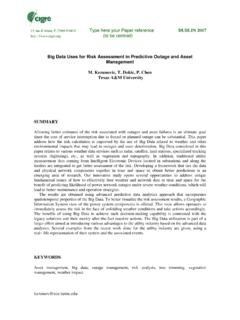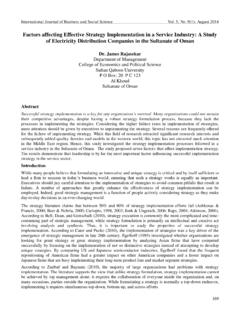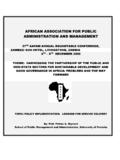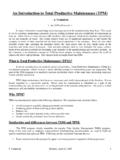Transcription of How to Design and Evaluate Research in Education …
1 Data Definitions Adapted from the Glossary How to Design and Evaluate Research in Education by Jack R. Fraenkel and Norman E. Wallen, A A- B Design A single- subject experimental Design in which measurements are repeatedly made until stability is presumably established (baseline), after which treatment is introduced and an appropriate number of measurements are made. A- B- A Design Same as the A- B Design except a second baseline is added. A- B- A- B Design A single- subject experimental Design in which measurements are repeatedly made until stability is presumably established (baseline), after which treatment is introduced and an appropriate number of measurements are made; the treatment phase is followed by a second baseline phase, which is followed by a second treatment phase.
2 Accessible population The population from which the researcher can realistically select subjects for a sample, and to which the researcher is entitled to generalize findings. achievement test An instrument used to measure the proficiency level of individuals in given areas of knowledge or skill. age- equivalent score A score that indicates the age level for which a particular performance (score) is typical. B B- A- B Design A treatment followed by a baseline followed by a return to the treatment. baseline The graphic record of measurements taken prior to introduction of an intervention in a time- series Design . C case study An in- depth investigation of an individual, group, or institution to determine the variables, and relationship among the variables, influencing the current behavior or status of the subject of the study.
3 Categorical data variables Data (variables) that differ only in kind, not in amount or degree. causal- comparative Research Research that attempts to determine the cause for, or consequences of, existing differences in groups of individuals; also referred to as ex post facto Research . cluster sampling cluster random sampling The selection of groups of individuals, called clusters, rather than single individuals; all individuals in a cluster are included in the sample; the clusters are preferably selected randomly from the larger population of clusters. comparison group The group in a Research study that receives a different treatment from that of the experimental group. concurrent validity (evidence of) The degree to which the scores on an instrument are related to the scores on another instrument administered at the same time, or to some other criterion available at the same time.
4 Confidence interval An interval used to estimate a population value. It is constructed in such a way that the interval has a predetermined probability of including the value. constant A characteristic that has the same value for all individuals. constitutive definition Explanation of the meaning of a term by using other words to describe concisely what is meant. construct- related validity (evidence of) The degree to which an instrument measures an intended hypothetical psychological construct, or nonobservable trait. content analysis The process of inductively establishing a categorical system for organizing open- ended information. content- related validity (evidence of) The degree to which an instrument logically appears to measure an intended variable, as determined by expert judgment.
5 Control group 7KH JURXS LQ D UHVHDUFK VWXG\ WKDW LV WUHDWHG DV XVXDO convenience sample A sample that is easily accessible. correlational Research Research that involves collecting data in order to determine the degree to which a relationship exists between two or more variables. counterbalanced Design An experimental Design in which all groups receive all treatments. Each group receives the treatments in a different order, and all groups are posttested after each treatment. criterion- related validity (evidence of) The degree to which performance on an instrument is related to performance on other instruments intended to measure the same variable, or to other variables logically related to the variable being measured.
6 D data Any information obtained about a sample. data collector bias Unintentional behaviors or expectations on the part of data collectors that may create a threat to the internal validity of a study. dependent variable A variable affected or expected to be affected by the independent variable; also called criterion or outcome variable. derived score A score obtained from a raw score in order to aid in interpretation. Derived scores provide a quantitative measure of each subject's performance relative to a comparison group. descriptive Research study Research that attempts to describe existing conditions without analyzing relationships among variables. descriptive statistics Data analysis techniques enabling the researcher to meaningfully describe data with numerical indices or in graphic form.
7 Descriptors Terms used to locate sources during a computer search of the literature. directional hypothesis A relational hypothesis stated in such a manner that a GLUHFWLRQ RIWHQ LQGLFDWHG E\ JUHDWHU WKDQ RU OHVV WKDQ LV K\SRWKHVL]HG IRU WKH . results. discussion (of a study) A review of the results including limitations of a study, placing the findings in a broader perspective. E ecological generalizability The degree to which results can be generalized to environments and conditions outside the Research setting. effect size An index used to indicate the magnitude of an obtained result or relationship. empirical Based on observable evidence. equivalent forms Two tests identical in every way except for the actual items included.
8 Equivalent- forms method A way of checking consistency by correlating scores on equivalent forms of an instrument in order to obtain a reliability coefficient; also referred to as alternate- forms reliability. errors of measurement Inconsistency of individual scores on the same instrument. ethnography ethnographic Research The collection of data on many variables over an extended period of time in a naturalistic setting, usually using observation and interviews. experiment A Research study in which one or more independent variables are systematically varied by the researcher to determine the effects of this variation. experimental group The group in a Research study that receives the treatment (or method) of special interest in the study.
9 Experimental Research Research in which at least one independent variable is manipulated, other relevant variables are controlled, and the effect on one or more dependent variables is observed. experimental variable The variable that is manipulated (systematically altered) in an intervention study by the researcher. external validity The degree to which results are generalizable, or applicable, to groups and environments outside the Research setting. extraneous event An event that is not part of an intervention but that may affect performance on the dependent variable, thereby influencing results and affecting internal validity; also referred to as a history threat to internal validity. extraneous variable A variable that makes possible an alternative explanation of results; an uncontrolled independent variable.
10 F factorial Design An experimental Design that involves two or more independent variables (at least one of which is manipulated) in order to study the effects of the variables individually, and in interaction with each other, upon a dependent variable. frequency polygon A graphic method of showing all the scores obtained by a group of individuals. field diary A personal statement of a researcher's opinions about people and events he or she comes in contact with during Research . field jottings Quick notes taken by an ethnographer. field log A running account of how an ethnographer plans to, and actually does, spend his or her time in the field. field notes The notes researchers take about what they observe and think about in the field.








